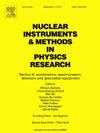Performance envelope of laser wakefield accelerators
IF 1.5
3区 物理与天体物理
Q3 INSTRUMENTS & INSTRUMENTATION
Nuclear Instruments & Methods in Physics Research Section A-accelerators Spectrometers Detectors and Associated Equipment
Pub Date : 2025-04-02
DOI:10.1016/j.nima.2025.170468
引用次数: 0
Abstract
Laser wakefield accelerator experiments have made enormous progress over the past years, but their promise to revolutionize high-energy particle sources is only beginning to be realized. To make the next step toward engineering LWFAs for different accelerator outcomes, we need more reliable and quantitative models to predict performance. Using the data from published experiments, we estimate scalings and the performance envelope. We compare the observed scalings with several models in the literature. We find that the total beam energy (centroid energy times beam charge) scales almost linearly with laser energy, supporting the value of investment in progressively higher energy driver lasers. The dataset includes pulse durations from 8 to 160 fs, but only laser wavelengths of 800 nm and 1 µm, meaning we could not check proposed wavelength scalings for alternative laser technologies. As a benchmark next-generation case, the observed scalings suggest that achieving a 100-GeV LWFA stage will require a PW laser operating at electron density cm.
激光汪场加速器的性能包络线
激光尾流场加速器实验在过去的20年里取得了巨大的进步,但它们对高能粒子源的革命的承诺才刚刚开始实现。为了进一步设计lwfa以适应不同的加速器结果,我们需要更可靠和定量的模型来预测性能。使用来自50个已发表实验的数据,我们估计了缩放和性能包络。我们将观察到的标度与文献中的几个模型进行比较。我们发现,光束总能量(质心能量乘以光束电荷)几乎与激光能量成线性关系,这支持了在逐步提高能量的驱动激光器上的投资价值。数据集包括从8到160 fs的脉冲持续时间,但只有800 nm和1 μ m的激光波长,这意味着我们无法检查替代激光技术的波长缩放。作为下一代的基准案例,观测到的尺度表明,要达到100 gev的LWFA阶段,需要在电子密度<;1017/cm3下工作的约30 PW激光。
本文章由计算机程序翻译,如有差异,请以英文原文为准。
求助全文
约1分钟内获得全文
求助全文
来源期刊
CiteScore
3.20
自引率
21.40%
发文量
787
审稿时长
1 months
期刊介绍:
Section A of Nuclear Instruments and Methods in Physics Research publishes papers on design, manufacturing and performance of scientific instruments with an emphasis on large scale facilities. This includes the development of particle accelerators, ion sources, beam transport systems and target arrangements as well as the use of secondary phenomena such as synchrotron radiation and free electron lasers. It also includes all types of instrumentation for the detection and spectrometry of radiations from high energy processes and nuclear decays, as well as instrumentation for experiments at nuclear reactors. Specialized electronics for nuclear and other types of spectrometry as well as computerization of measurements and control systems in this area also find their place in the A section.
Theoretical as well as experimental papers are accepted.

 求助内容:
求助内容: 应助结果提醒方式:
应助结果提醒方式:


